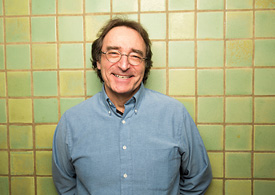
Photo by Austin Thomason, Michigan Photography.
Imagine sitting in a high school history class and learning about the life cycle of stars in a seven-minute video lecture by a world-renowned astronomer.
As part of the Big History Project, high school students around the world are doing just that.
“Big History is an approach to history that starts with the Big Bang and then integrates multiple disciplines — such as physics, geology, anthropology and history — to help students investigate how it is we’ve arrived at the present,” says Bob Bain, an associate professor in the School of Education and LSA’s Department of History.
“It encourages students to think about how our solar system formed, why continents are where they are, the chemical composition of our resources, where commodities we use come from, and the largest scaled stories of human history. It trumps world history by about 13.5 billion years.”
While teaching high school history in Cleveland, Bain came across a journal article about David Christian of Macquarie University in Australia, who had created a college-level course that explained the history of the universe and our world.
Ask Bob Bain
What can’t you live without?
I seem to need a few cups of coffee in the morning!
What is your favorite spot on campus?
On the steps of Rackham, looking back out over the campus.
What inspires you?
Music. I love listening to John Coltrane; “A Love Supreme” always seems to move me.
What are you currently reading?
“The Ongoing Moment” by photographer Geoff Dyer, and “Knocking on Heaven’s Door” by physicist Lisa Randall. I would’ve read the first book 15 years ago, but the second one, that’s a byproduct of the Big History work.
Who had the greatest influence on your career path?
One of my undergraduate professors at Ohio State University in a class on the history of education. He showed me that ideas have a life of their own and I shifted my studies from premed to history and education after taking it. I even met my wife through his class.
Bain communicated with Christian, and when he joined the School of Education in 1998, the two collaborated on a world history website. Ten years later, Bain received a phone call from bgC3, or Bill Gates Catalyst 3, the private company of the Microsoft co-founder.
Gates had taken Christian’s Big History course online and wanted to make it accessible to high schools. Christian suggested that Bain play a role in creating the program because of his 26 years teaching high school history and research on teaching and learning history.
“Together, we constructed the learning outcomes, the curriculum, the assessments, and started creating the video lectures,” says Bain, who also is chair of secondary teacher education in SOE. Along with the short clips, the Big History Project website boasts comics, animations, images, in-class activity guides, timelines and texts.
The 2011-12 school year was the pilot year for the Big History Project, which was in seven U.S. schools, including independent, suburban, and urban schools. This year 70 schools around the globe are participating. They include English-language schools in Scotland, Singapore, Brazil, Korea, Canada, and Australia.
“Next year we’re going to scale, with anywhere from 200-500 schools in the project,” says Bain.
As an education professor, Bain teaches and studies how classroom learning works. “The Big History curriculum is educative not only for the student, but for the teachers, too,” he says.
The weekly Spotlight features faculty and staff members at the university. To nominate a candidate, please contact the Record staff at [email protected].

